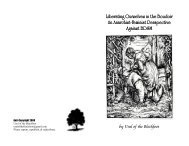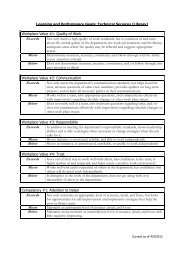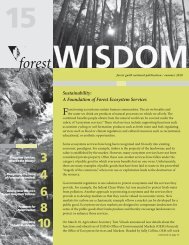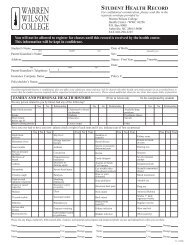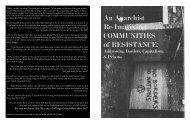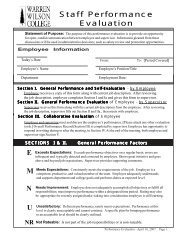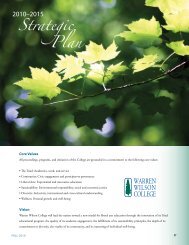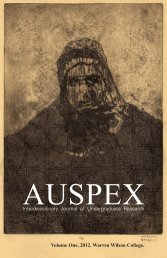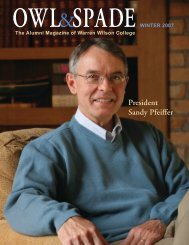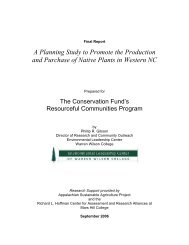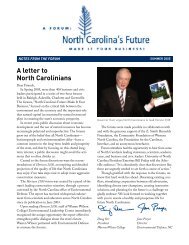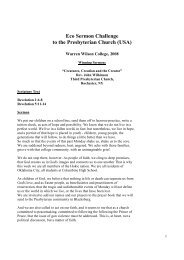Native American and Spanish Ancillary Structures - Warren Wilson ...
Native American and Spanish Ancillary Structures - Warren Wilson ...
Native American and Spanish Ancillary Structures - Warren Wilson ...
Create successful ePaper yourself
Turn your PDF publications into a flip-book with our unique Google optimized e-Paper software.
Introduction<br />
One thing that all cultures have in common is<br />
that they require the utilization of space. The choices<br />
that cultures make about how to use that space reflect<br />
social organization <strong>and</strong> systems of meaning for<br />
particular cultures. One choice societies have is where<br />
<strong>and</strong> where not to build. On a large scale, this means<br />
deciding where to establish a village within a region.<br />
On a smaller scale, villagers must decide where to build<br />
a house within the village or where to build a fence in<br />
relation to the house.<br />
Space in a village is divided into three groups:<br />
domestic space, ceremonial space, <strong>and</strong> public space.<br />
Archaeological excavations of public <strong>and</strong> ceremonial<br />
space contain information about the leaders of society:<br />
they tell the stories of the great men <strong>and</strong> women of the<br />
time. Excavations of domestic space tell a different<br />
story: they contain information about how people lived<br />
their everyday lives. They tell not only the stories of the<br />
great leaders but also of the common people who made<br />
village life possible.<br />
Domestic space includes both the household<br />
<strong>and</strong> the area surrounding the household (Gougeon<br />
2007:140). Throughout North <strong>American</strong> prehistory,<br />
before written records, most domestic activity took<br />
place outside of the house, including cooking <strong>and</strong> craft<br />
making. Studies of the architecture of this outdoor<br />
domestic space inform us about how people interacted<br />
with each other <strong>and</strong> what activities took place. We can<br />
learn about the materials they used, what they used<br />
those materials for, <strong>and</strong> the significance of this humanmade<br />
domestic environment.<br />
The Berry site in Morganton, North Carolina, is<br />
one site where studying outdoor domestic space could<br />
aid our underst<strong>and</strong>ing of past everyday life, specifically<br />
life during the contact period in the interior of the<br />
eastern United States. Architecture at the Berry site can<br />
provide information about such aspects of life as political<br />
organization, economic organization, subsistence, <strong>and</strong><br />
aesthetic tastes. Previous research has been done on<br />
the burnt structures associated with the <strong>Spanish</strong> Fort<br />
San Juan in order to examine the relationship between<br />
<strong>Spanish</strong> soldiers <strong>and</strong> native villagers, but research has<br />
not yet explored outdoor domestic space between the<br />
structures (Beck, Moore, <strong>and</strong> Rodning 2006; Best <strong>and</strong><br />
Rodning 2003). Research on these outdoor activity areas<br />
is important because the fort is thought to be located on<br />
an old section of the village, so there is the possibility<br />
of evidence of both native <strong>and</strong> <strong>Spanish</strong> activity, much<br />
of which took place outside.<br />
This study examines the use of outdoor domestic<br />
space at the Berry Site by studying posthole distribution<br />
outside of the known structures. This research analyzes<br />
the dimensions <strong>and</strong> characteristics of the postholes<br />
<strong>and</strong> their spatial relationships, <strong>and</strong> compares these<br />
characteristics to postholes in known structures at<br />
the Berry site <strong>and</strong> at other Mississippian <strong>and</strong> colonial<br />
<strong>Spanish</strong> sites. I explore evidence of Mississippian<br />
<strong>and</strong> <strong>Spanish</strong> architectural structures via the postholes<br />
they left behind. Data from this study contribute to<br />
our underst<strong>and</strong>ing of interactions between villagers<br />
<strong>and</strong> <strong>Spanish</strong> soldiers by illuminating characteristics of<br />
the built environment <strong>and</strong> activity areas in the outdoor<br />
domestic space of Fort San Juan <strong>and</strong> Joara during <strong>and</strong><br />
preceding the time of <strong>Spanish</strong> contact in 1567.<br />
Research Framework<br />
The Mississippian Period denotes societies<br />
in the southeastern United States from around A.D.<br />
1000 to A.D. 1500 <strong>and</strong> includes societies with similar<br />
styles of artifacts, architecture, <strong>and</strong> settlement patterns<br />
(Boudreaux 2007). Important <strong>and</strong> relevant themes in the<br />
literature are Mississippian town designs, architectural<br />
designs, <strong>and</strong> how posthole patterns inform the research<br />
of both. Previous research on these topics aided my<br />
own research on posthole patterns at the Berry site<br />
<strong>and</strong> helped me underst<strong>and</strong> the meaning of its built<br />
environment.<br />
Ethnohistoric <strong>and</strong> Archaeological Background<br />
of the Berry Site<br />
The ethnohistoric <strong>and</strong> archaeological records<br />
provide evidence of both <strong>Native</strong> <strong>American</strong> <strong>and</strong><br />
<strong>Spanish</strong> occupation at the Berry site. Ethnohistoric<br />
documents show that <strong>Spanish</strong> soldiers traveled through<br />
the southeastern United States, including the area<br />
where the Berry site is located. During these travels,<br />
<strong>Spanish</strong> soldiers interacted with <strong>Native</strong> <strong>American</strong>s <strong>and</strong><br />
established permanent <strong>and</strong> temporary settlements.<br />
One group of <strong>Spanish</strong> soldiers came from Santa<br />
Elena, the capital of sixteenth-century <strong>Spanish</strong> Florida,<br />
established in 1566, located on the southern tip of<br />
modern-day Parris Isl<strong>and</strong>, South Carolina. Later that<br />
year, 250 soldiers arrived in Santa Elena to reinforce<br />
the colony. Because Santa Elena was not prepared to<br />
feed all of the soldiers, Captain Juan Pardo took half<br />
of his men on an exploring expedition of the interior<br />
l<strong>and</strong>s. During Pardo’s expeditions, he built a total of<br />
six forts, with the first <strong>and</strong> most important being Fort<br />
San Juan, located at the native town of Joara (Beck,




